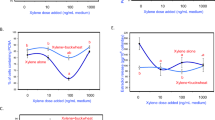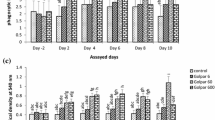Abstract
To improve the utility of the inedible ovary of puffer fish, heat and alkaline conditions (pH 9.0) were applied to eliminate its toxicity. The alkaline- and heat- treated ovary extract showed no lethal potential in any group tested using a mouse bioassay and a brine shrimp lethality assay. In addition, the considerable anti-erythematic and anti-edematic effects of detoxified puffer fish ovary extract were evaluated. Based on the results, detoxified puffer fish ovary extract is a promising source of novel anti-inflammatory agents that may be useful when included in dermal care products and for the development of novel therapies for dermal diseases.
Similar content being viewed by others
References
National Institute of Fisheries Science (NIFS), https://www.nifs.go.kr/portal/page?id=harmful_material2_04 (2017).
Kang, Y. W., Lee, Y. S., Park, S. K,. Seo J. H. & Kim, M. H. The study on the analysis method of tetrodotoxin in puffer fish. J. Fd. Hyg. Safety 27, 37–41 (2012).
Matsumoto, T. et al. Plasma protein binding of tetrodotoxin in the marine puffer fish Takifugu rubripes. Toxicon 55, 415–420 (2010).
Kinghorn, A. D., Jawad, F. H. & Doorenbos, N. J. Structure-activity relationship of grayanotoxin derivatives using a tetrodotoxin-antagonized spasmodic response of brine shrimp larvae (Artemia salina). Toxicon 16, 227–234 (1978).
Kobayashi, T., Kimura, B. & Fujii, T. Decrease of toxicity during storage of fermented puffer fish ovaries in vitro. J. Food Hyg. Soc. Japan 40, 178–182 (1999).
Korea Food and Drug Administration (KFDA) in Provisory regulation on fisheries products in food standard (Munyeongsa, Seoul, 2004).
Ozawa, C. Sodium bicarbonate-accelerated detoxification of puffer ovaries during pickled product processing. Nippon Suisan Gakkaishi 52, 2177–2181 (1986).
Jang, J. H., Yun, S.-M., Kim, J.-S. & Lee, J.-S. Toxin profile in the liver of puffer fish, Takifugu niphobles, and changes in mouse toxicity by pH and heating conditions. J. Korean Soc. Food Sci. Nutr. 7, 612–617 (2008).
Kim, S. K., Kim, B. K., Shin, J. S. & Shin, J. S. Method of dexoxifying the egg of puffer fish for creating healthy foodstuffs and the resulting product. US 20030211226 A1 (2003).
Cha, B.-Y. et al. Separation of tetrodotoxin, DHA and EPA from pufferfish liver waste. Korean J. Life Sci. 10, 115–124 (2000).
Hille, B. The receptor for tetrodotoxin and saxitoxin. Biophys. J. 15, 615–619 (1975).
Ozawa, C. Effect of the presence of alkalis during salting on the toxicity of puffer roe. Shokuhin Eiseigaku Zasshi 24, 263–267 (1983).
Sharma, A. & Loffeld, A. The management of eczema in children. Paediatr. Child Health 25, 54–59 (2015).
Dongeuichiryokyeonghum Compilation Committee in Dongeuichiryokyeonghum (Yeogang Publishing Company, Seoul, 2001).
Suehiro, M. Historical review on chemical and medical studies of globefish toxin before World War II. Japanese Society for History of Pharmacy. Yakushigaku Zasshi 29, 428–434 (1994).
Mosher, H. S. & Fuhrman, F. A. in Occurrence and origin of tetrodotoxin (ACS Publications, Washington, D.C., 1984).
Mirbakhsh, K. & Göransson, U. in Tetrodotoxin -evolutionary selection and pain relief (Course in Biological Active Natural Products in Drugdiscovery A8/C, Uppsala University, Uppsala, 2004).
Kawabata, T. in Pufferfish toxin. The manual for the methods of food sanitation tests II (Japan Food Hygienic Association, Tokyo, 1978).
Wanlem, S. et al. Susceptibility and physiological responses to tetrodotoxin in white shrimp (Litopenaeus vannamei). Fish Shellfish Immunol. 34, 1745 (2013).
Fatope, M. O., Ibrahim, H. & Takeda, Y. Screening of higher plants reputed as pesticides using the brine shrimp lethality assay. Int. J. Pharmacogn. 13, 250–254 (1993).
Padmaja, R. et al. Brine shrimp lethality bioassay of selected Indian medicinal plants. Fitoterapia 73, 508–510 (2002).
Lane, C. B. Toxins of marine origin. Annu. Rev. Pharmacol. 8, 409–426 (1968).
Zhang, Y., Mu, J., Han, J. & Gu, X. An improved brine shrimp larvae lethality microwell test method. Toxicol. Mech. Methods 22, 23–30 (2012).
Milhem, M. M., Al-Hiyasat, A. S. & Darmani, H. Toxicity testing of restorative dental materials using brine shrimp larvae (Artemia salina). J. Appl. Oral Sci. 16, 297–301 (2008).
Kim, Y. D. & Choi, J.-S. Larvicidal activity of Korean seaweed extracts against brine shrimp Artemia salina. J. Anim. Plant Sci. 27, in press. (2017).
Solis, P. N., Wright, C. W., Anderson, A. M., Gupta, M. E. & Phillipson, J. D. A microwell cytotoxicity assay using Artemia salina (brine shrimp). Planta Med. 59, 250–252 (1993).
Khan, M. N. A. et al. Effects of the brown seaweed Undaria pinnatifida on erythematous inflammation assessed using digital photo analysis. Phytother. Res. 22, 634–639 (2008).
Choi, J.-S. et al. Anti-erythema and anti-edema activities of lactic acid bacteria extracts in mice. Toxicol. Environ. Health Sci. 9, 1–9 (2017).
Khan, M. N. A. et al. Anti-edema effects of brown seaweed (Undaria pinnatifida) extract on phorbol 12-myristate 13-acetate-induced mouse ear inflammation. Am. J. Chin. Med. 37, 373–381 (2009).
Korea Food and Drug Administration (KFDA) in Food Standards Codex (Korea Food and Drug Administration, Seoul, 2005).
Author information
Authors and Affiliations
Corresponding author
Rights and permissions
About this article
Cite this article
Kim, Y.D., Kim, SK. & Choi, JS. Toxicity and anti-inflammatory activity of detoxified puffer fish ovary. Toxicol. Environ. Health Sci. 9, 116–122 (2017). https://doi.org/10.1007/s13530-017-0311-7
Received:
Revised:
Accepted:
Published:
Issue Date:
DOI: https://doi.org/10.1007/s13530-017-0311-7




